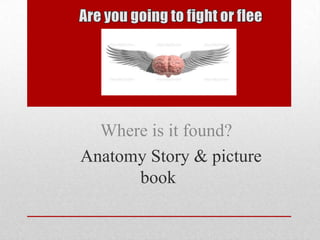
Are you going to fight or fleet.pptx (1)
- 1. Where is it found? Anatomy Story & picture book
- 2. The meninges contain cerebral spinal fluid. And provides extra support and protection for the brain. The formation of cerebrospinal fluid occurs mainly by separation of fluid from blood in Choroid plexuses. The average cerebrospinal fluid in the average adult is about 140 ml (13) • Meninges
- 3. • Middle layer: known as DURA MATER • Outer layer: known as ARACHNOID • Inner layer: Known as PIA MATER(15) This is a picture of the dura matter layer, or the outer layer. Underneath the dura is the inner and middle layers. (16) Types of meninges
- 4. Spinal Cord and Brain Stem
- 5. • Helps in connecting the various organs of human body to the brain • Spinal cord is a long and narrow structure made up of nervous tissues and support cells • It sends the signals from the motor area of the brain back to the various parts of the body • Guides some of the most important human body systems, and any damage caused to it can lead to certain complications in the body See Also Nerve Roots • Cervical spine nerve roots. In the cervical spine (neck), the nerve root is named for the lower segment that it runs between (e.g. C6 nerve root at C5-C6 segment). • Lumbar spine nerve roots. In the lumbar spine (lower back), the nerve is named for the upper segment that it runs between (e.g. L4 nerve root at L4-L5 segment). (13)(22) Spinal Cord
- 6. C-20
- 7. • Functions as our own privet "auto-pilot". • It is located at lower part of the brain, directly connected to the spinal cord. The neurological functions located in the brainstem include: • Breathing, digestion, heart rate, blood pressure and arousal See also Medulla Oblongata and Midbrain (21) Brain Stem
- 8. C-20
- 9. Structure and Function of the the brain. Cerebellum • The Cerebellum is a cauliflower-shaped lobe of Cerebellum means “Little brain” in Latin. The cerebellum is divided into three major parts. • The Vermis: a narrow, worm shaped structure in between both sides of the cerebellum. • The Paravermis: A region on either side of the midline of the cerebellum that lies lateral to the Vermis and medial to the hemisphere • The Cerebellar Hemispheres: The hemispheres are coated in a thin layer of grey matter called the cortex. Under the cortex, there is a white layer and in that layer are deep cerebellar nuclei. • This part of the brain is in charge of the motor control of that regulates muscle tone and coordinate the movement. It is also believed that it contributes to non-motor functions, such as thought process and emotions. It is important that it receives and sends the messages to for the production of muscle movement and coordination. • See also NeuroScience For Dumbies
- 10. Structure and Function of Diencephalon • It is made up of the pons, medulla oblongata, and the midbrain. • It’s two major divisions are: the thalamus and the hypothalamus. • Thalamus: is an important relay station for sensory information, translating sensations of sound, smell, taste, pain, pressure, temperature, and touch. It also controls some of memories and emotions. • Hypothalamus: it controls the heartbeat rate and digestion, helps regulate the endocrine system and the body temperature, it also interprets hunger and thirst, and regulates sleep, anger, and aggression. • The diencephalon is like a relay system between the input sensory neurons and other parts of the brain. It interconnects with other larger surrounding structures called the limbic system, which controls the memories and emotions.
- 11. Structure and Function of the Cerebral Cortex • The cerebral cortex can control sensations, voluntary muscle movement, thought, reasoning, and memory. The wrinkles, folds, and crumpled curves allow for more surface area to pack in more cortical neurons. The neurons carry out the rational thoughts and emotions. The cerebral cortex is apart of the limbic system.
- 12. Somatic Sensory Pathways in the CNS • There are a few major parts/systems to the somatic sensory pathways: the anterolateral and lemniscal systems. • Anterolateral system: the cells of origin of pain and temperature conveying axons in the spinal cord lie in the dorsal horn. Axons arising from these dorsal horn cells cross and ascend in the anterolateral portion of the white matter of the spinal cord • Lemniscal system: Axons of cells within nucleus gracilis and nucleus cuneatus cross as internal arcuate fibers and form this system. It carries information from specialized touch, pressure, vibration, and joint receptors to the cerebral cortex.
- 16. Afferent and Efferent nerves • Afferent or sensory neurons receive information from the outside (sensory receptors) and sends them to other neurons so the body could produce a response. • Efferent neurons or motor neurons receive information from other neurons and sends that information to effectors (muscles,glands), which produce a response.
- 17. • The autonomic nervous system is a part of the peripheral nervous system that functions to regulate the basic visceral processes needed for the maintenance of normal bodily functions. It operates independently of voluntary control, although certain events, such as emotional stress, fear, sexual excitement, and alterations in the sleep- wakefulness cycle, change the level of autonomic activity. Autonomic nervous system
- 18. • The sympathetic nervous system belongs to autonomic nervous system along with parasympathetic nervous system. The sympathetic nerves starts from the spinal column running towards the middle part of spinal cord in the lateral horn. It originates at the spinal cord’s first thoracic segment and extends to third lumbar segment. Sympathetic Nervous System
- 19. • The part of the involuntary nervous system that serves to slow the heart rate, increase intestinal and glandular activity, and relax the sphincter muscles. The parasympathetic nervous system, together with the sympathetic nervous system, constitutes the autonomic nervous system. Parasympathetic nervous system